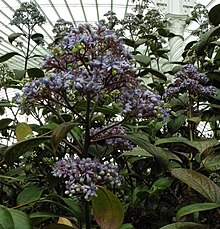| Dichroa febrifuga | |
|---|---|

| |
| Scientific classification | |
| Kingdom: | Plantae |
| Clade: | Tracheophytes |
| Clade: | Angiosperms |
| Clade: | Eudicots |
| Clade: | Asterids |
| Order: | Cornales |
| Family: | Hydrangeaceae |
| Genus: | Dichroa |
| Species: | D. febrifuga
|
| Binomial name | |
| Dichroa febrifuga | |

Dichroa febrifuga is a flowering plant in the family Hydrangeaceae.
National names[edit]
- Chinese: Chinese: 常山; pinyin: ⓘ)
- Indonesian language: gigil, alternatively tataruman
- Sundanese: ramram
- Papua: Hom dong (ฮอมดง):
- Thai: Yai khlang yai (ยายคลังใหญ่), in Nakhon Sri Thammarat, Yai Krang (ยายกรัง) in the South, and Hom Kham (ฮอมคำ) in Lanna (Northern Thai).
Traditional Chinese medicine[edit]
Dichroa febrifuga is an important herb in traditional Chinese medicine, where it is considered one of the 50 fundamental herbs.[2] The alkaloids febrifugine and isofebrifugine are believed to be responsible for its antimalarial effects.[3] In traditional preparations, it is used in conjunction with other plants such as Glycyrrhiza glabra (licorice), Ziziphus jujuba and Zingiber officinale (ginger).[4]
Potential drug against autoimmune disease[edit]
Halofuginone, sold under the brand name Halocur, is a coccidiostat used in veterinary medicine. It is a synthetic halogenated derivative of febrifugine, a natural quinazolinone alkaloid which can be found in dichroa febrifuga.[5]
Halofuginone inhibits the development of T helper 17 cells, immune cells that play an important role in autoimmune disease, but it does not affect other kinds of T cells which are involved in normal immune function.[6] Halofuginone therefore has potential for the treatment of autoimmune disorders.[7]
References[edit]
- ^ "Dichroa febrifuga". Germplasm Resources Information Network. Agricultural Research Service, United States Department of Agriculture. Retrieved 2008-02-05.
- ^ "Dichroa febrifuga - Plants For A Future database report". Retrieved 2008-02-05.
- ^ Zhu, Shuren; Meng, Li; Zhang, Quan; Wei, Lai (2006). "Synthesis and evaluation of febrifugine analogues as potential antimalarial agents". Bioorganic & Medicinal Chemistry Letters. 16 (7): 1854–1858. doi:10.1016/j.bmcl.2006.01.009. PMC 2072810. PMID 16434194.
- ^ Rasoanaivo, Philippe; Wright, Colin W; Willcox, Merlin L; Gilbert, Ben (2011). "Whole plant extracts versus single compounds for the treatment of malaria: Synergy and positive interactions". Malaria Journal. 10 (Suppl 1): S4. doi:10.1186/1475-2875-10-S1-S4. PMC 3059462. PMID 21411015.
- ^ "Halofuginone hydrobromide". NCI Drug Dictionary. National Cancer Institute, National Institutes of Health, U.S. Department of Health and Human Services.
- ^ Sundrud MS, Koralov SB, Feuerer M, Calado DP, Kozhaya AE, Rhule-Smith A, et al. (June 2009). "Halofuginone inhibits TH17 cell differentiation by activating the amino acid starvation response". Science. 324 (5932): 1334–8. Bibcode:2009Sci...324.1334S. doi:10.1126/science.1172638. PMC 2803727. PMID 19498172.
- ^ Sundrud MS, Koralov SB, Feuerer M, Calado DP, Kozhaya AE, Rhule-Smith A, Lefebvre RE, Unutmaz D, Mazitschek R, Waldner H, Whitman M, Keller T, Rao A (June 2009). "Halofuginone inhibits TH17 cell differentiation by activating the amino acid starvation response". Science. 324 (5932): 1334–8. Bibcode:2009Sci...324.1334S. doi:10.1126/science.1172638. PMC 2803727. PMID 19498172.
- "A new lead for autoimmune disease". EurekAlert! (Press release). 4 June 2009.
External links[edit]